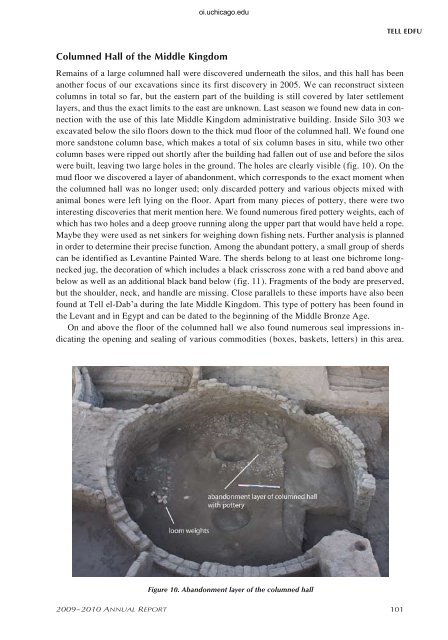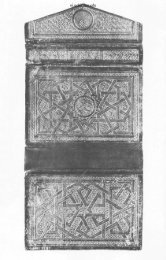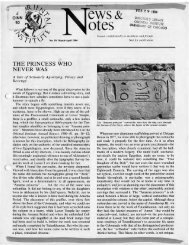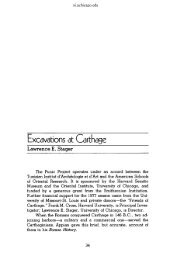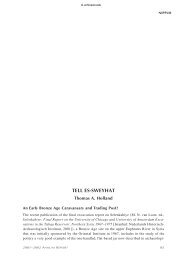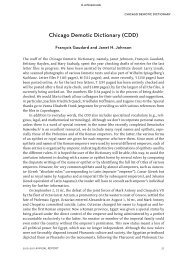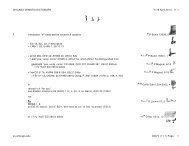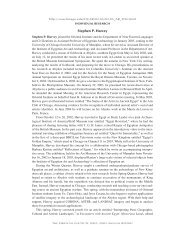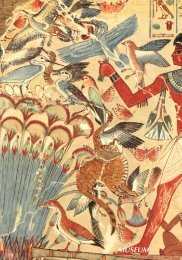TELL EDFU. Nadine Moeller - Oriental Institute - University of Chicago
TELL EDFU. Nadine Moeller - Oriental Institute - University of Chicago
TELL EDFU. Nadine Moeller - Oriental Institute - University of Chicago
Create successful ePaper yourself
Turn your PDF publications into a flip-book with our unique Google optimized e-Paper software.
oi.uchicago.edu<br />
Columned Hall <strong>of</strong> the Middle Kingdom<br />
Tell edfu<br />
Remains <strong>of</strong> a large columned hall were discovered underneath the silos, and this hall has been<br />
another focus <strong>of</strong> our excavations since its first discovery in 2005. We can reconstruct sixteen<br />
columns in total so far, but the eastern part <strong>of</strong> the building is still covered by later settlement<br />
layers, and thus the exact limits to the east are unknown. Last season we found new data in connection<br />
with the use <strong>of</strong> this late Middle Kingdom administrative building. Inside Silo 303 we<br />
excavated below the silo floors down to the thick mud floor <strong>of</strong> the columned hall. We found one<br />
more sandstone column base, which makes a total <strong>of</strong> six column bases in situ, while two other<br />
column bases were ripped out shortly after the building had fallen out <strong>of</strong> use and before the silos<br />
were built, leaving two large holes in the ground. The holes are clearly visible (fig. 10). On the<br />
mud floor we discovered a layer <strong>of</strong> abandonment, which corresponds to the exact moment when<br />
the columned hall was no longer used; only discarded pottery and various objects mixed with<br />
animal bones were left lying on the floor. Apart from many pieces <strong>of</strong> pottery, there were two<br />
interesting discoveries that merit mention here. We found numerous fired pottery weights, each <strong>of</strong><br />
which has two holes and a deep groove running along the upper part that would have held a rope.<br />
Maybe they were used as net sinkers for weighing down fishing nets. Further analysis is planned<br />
in order to determine their precise function. Among the abundant pottery, a small group <strong>of</strong> sherds<br />
can be identified as Levantine Painted Ware. The sherds belong to at least one bichrome longnecked<br />
jug, the decoration <strong>of</strong> which includes a black crisscross zone with a red band above and<br />
below as well as an additional black band below (fig. 11). Fragments <strong>of</strong> the body are preserved,<br />
but the shoulder, neck, and handle are missing. Close parallels to these imports have also been<br />
found at Tell el-Dab’a during the late Middle Kingdom. This type <strong>of</strong> pottery has been found in<br />
the Levant and in Egypt and can be dated to the beginning <strong>of</strong> the Middle Bronze Age.<br />
On and above the floor <strong>of</strong> the columned hall we also found numerous seal impressions indicating<br />
the opening and sealing <strong>of</strong> various commodities (boxes, baskets, letters) in this area.<br />
Figure 10. Abandonment layer <strong>of</strong> the columned hall<br />
2009–2010 annual repOrT 101


